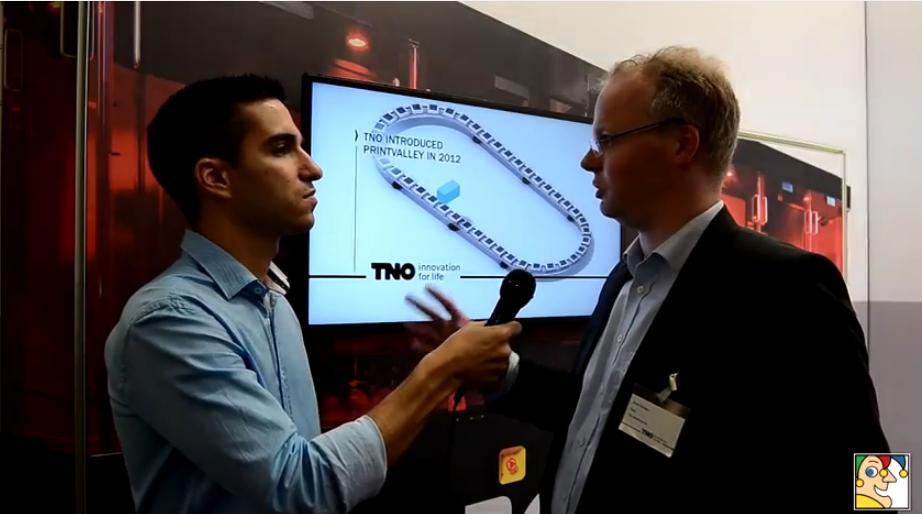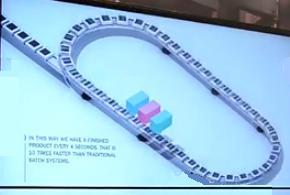 Perhaps you read the title of this article, and automatically assumed that we made a typo. After all, it sounds awfully similar to a story we did in the past about 3D Systems.
Perhaps you read the title of this article, and automatically assumed that we made a typo. After all, it sounds awfully similar to a story we did in the past about 3D Systems.
If you have been following the 3D printing space for the past several months, then you know that 3D Systems has been working on creating a new 3D printing system that they say is based on a “racetrack architecture”. It is an assembly line of sorts, and is said to be able to fabricate objects up to 50 times faster than other printers currently available today. Now a little over seven months since they revealed details of this potentially revolutionary 3D printing process, a dutch research center, called TNO, reveals that they too are working on similar technology.
In a video interview with The Motley Fool, René Houben, Senior Rapid Manufacturing Researcher at TNO, revealed the details and plans for this “new” technology.
Where the racetrack-like 3D printing system provides the most benefit over more conventional 3D printers, is in terms of speed. Because traditional 3D printing is based on a more “sequential” process, where single builds are fabricated using multiple steps, the process is extremely slow. Anyone who has been around 3D printing or themselves have 3D printed something realizes this.
“You can imagine, each process step is in fact waiting on the other process steps to finish,” explained Houben. “That is an enormous lack of time. All this time you’re not producing, you’re not building. This demonstration system, as we have it right now, is up to 10 times faster than comparable systems. Not by adding an enormous amount of print heads; it’s the same amount of print heads — state of the art, normal technology — but implemented in a more efficient manner.”
That more efficient manner is the racetrack architecture where the print heads are constantly printing onto a print bed, whether it be via selective laser sintering or other powder based 3D printing systems. This allows for the continuous movement of the build platforms — or possibly the print heads — while the print heads can also continuously extrude material or energy. Because the extruders do not have to stop and change direction like in a traditional 3D printer, rapid print speeds are made possible.
TNO uses the same print heads as other companies such as Stratasys, although they don’t purchase them directly from these companies. Instead they purchase them from the sources themselves. However, because the process is different, in that it is much faster and demands much more from each print head, modifications must be made on the part of TNO.
“When you’re suddenly using such a print head for 90% of the time instead of 10%, you’re processing an enormous amount of material and a lot of difficulties occur which need to be overcome,” said Houben.
TNO says the print speed is around two meters per second, and when using a “droplet demand system” can reach speeds of four meters per second. This requires not only modification of the print heads but of the entire printing systems as a whole.
Houben says that many different 3D printing technologies can work with this process. They include inkjet printing (successfully demonstrated already by TNO), as well as powder based printing with a powder bed, and laser sintering (also typically using a powder system). It doesn’t end here though, as Houben said that TNO is currently working on implementing powder and laser sintering methods together as part of one “racetrack” 3D printing system.
While this system seems eerily similar to what 3D Systems has been working on, I wonder if there will be any IP issues. We know from past examples that 3D Systems does not shy away from patent protection, so it should be interesting to see if TNO will have any legal issues with their technology. From an outsider’s point of view, it is really hard to determine.
TNO is currently looking for companies to collaborate with and hopefully bring this technology into real-world use. It should be interesting to see what the next couple of years have in store for the industry in terms of this large-scale additive manufacturing processes.
What do you think of TNO’s system? Does it seem too similar to the process that 3D Systems is using? Discuss in the TNO Racetrack 3D Printing system forum thread on 3DPB.com. Check out the Motley Fool interview with René Houben below.
Subscribe to Our Email Newsletter
Stay up-to-date on all the latest news from the 3D printing industry and receive information and offers from third party vendors.
You May Also Like
3D Printing Webinar and Event Roundup: April 7, 2024
Webinars and events in the 3D printing industry are picking back up this week! Sea-Air-Space is coming to Maryland, and SAE International is sponsoring a 3D Systems webinar about 3D...
Roboze Brings Performance Polymer 3D Printing to SoCal via New Partnership
High-performance polymer 3D printing firm Roboze has been steadily working to expand its global footprint, with a firm eye on distributed manufacturing, particularly with regard to the oil and gas,...
3D Printing Webinar and Event Roundup: March 3, 2024
In this week’s roundup, we have a lot of events taking place, including SPE’s ANTEC 2024, Futurebuild, the AAOP Annual Meeting, JEC World, and more. Stratasys continues its training courses,...
Advanced Manufacturing Firm Zeda Acquires The Orthopedic Implant Company
Zeda, the San Francisco-based provider of advanced manufacturing solutions, announced that it has acquired The Orthopedic Implant Company (OIC), a medical device manufacturer based in Reno, Nevada, for an undisclosed...

































